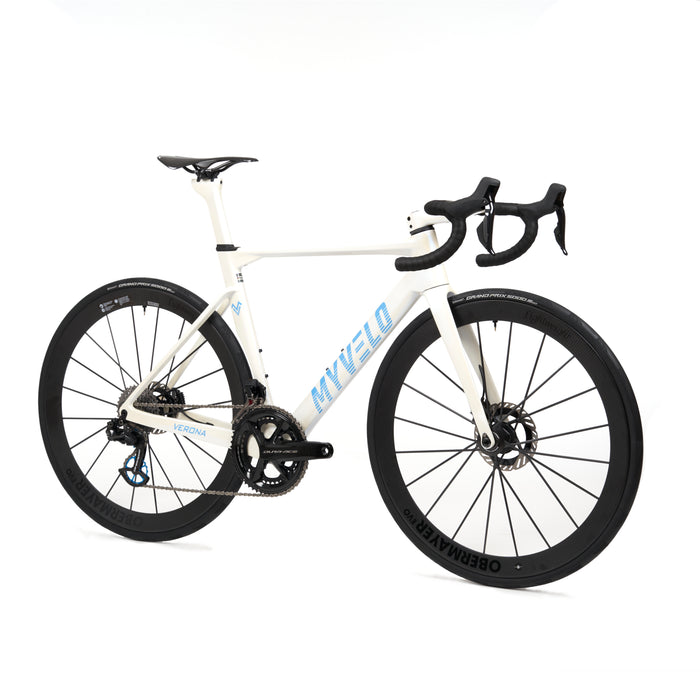
Verona Road Bike - Ltd. 33
incl. FREE shipping & free returns

Von Vincent Augustin |
4 minutes read time

In this article, you will learn everything you need to know about the headset on your racing bike – what it is exactly, how it works and why it is worth maintaining it regularly or even replacing it if necessary.
The headset is the component on the bike that connects the fork to the frame and ensures that your handlebars move smoothly. Essentially, the headset consists of several bearings that are housed in the head tube of the frame. These bearings allow you to turn the handlebars and thus the fork to steer the bike.
The headset is particularly important because it optimally distributes the loads that act on the steering when riding. A high-quality and well-functioning headset is essential, especially on a racing bike, where precision and stability at high speeds are important.
There are different types of headsets that differ in their construction, their integration into the frame and their bearing type. The three most common types are:
Threaded headset : This type is often found on older racing bikes. The headset is attached to the fork via a thread and nuts on the handlebars. Threaded headsets are robust, but are now somewhat outdated, as modern systems are easier to use.
Integrated headset : The integrated headset is the most modern and widely used design. Here, the bearings are integrated directly into the head tube of the frame, which allows for a very slim and clean look. This design saves weight while offering high rigidity, which is ideal for racing bikes.
Semi-integrated headset : This type is a cross between the other two. The bearings are in the head tube but housed in separate bearing cups. Semi-integrated headsets are a bit heavier than integrated models, but have the advantage of often being more robust and easier to maintain.
When you're out on your racing bike, the headset is put under a lot of strain. Every impact you absorb on the handlebars, every change of direction and every braking maneuver have a direct effect on the headset. That's why it plays a crucial role in the riding experience and safety.
A poorly adjusted or worn headset can lead to steering inaccurately. You may notice this because the handlebars are stiff or start to "shake" at high speeds. In the worst case, a defective headset can even lead to the steering locking - which can be life-threatening on fast descents.
A headset does not have an unlimited lifespan. The bearings wear out over time, especially when they become contaminated by dirt, dust or water. There are some typical signs that your headset needs servicing or replacement:
Maintaining the headset is not complicated, but requires a little technical understanding and the right tools. Here is a simple step-by-step guide:
Dismantling the headset : First you have to dismantle the handlebars, stem and fork. Make sure you remember exactly how the individual parts are assembled. Take photos of the assembly to be on the safe side.
Cleaning : Remove the headset from the frame and clean the bearings and bearing cups thoroughly. Contaminants are one of the main causes of wear.
Checking the bearings : Check if the bearings are damaged or do not move smoothly. Ball bearings should move without resistance. If the bearings are damaged, they must be replaced.
Lubrication : Apply a thin layer of high-quality bearing grease to the bearings and bearing shells before reassembling.
Reassembly : Reinstall the headset and make sure everything is secure but not over-tightened. The handlebars should turn without play but also without too much resistance.
Sometimes even the best care doesn't help and the headset has to be completely replaced. A change makes sense if:
Before you buy a new headset, you should make sure that it fits your frame and fork. The size of the headset depends on the diameter of the head tube and fork. It is best to measure the corresponding dimensions precisely or look at the specifications of your frame.
The material of the headset can also play a role. High-quality headsets are often made of aluminum or even carbon to minimize weight and increase stiffness. These options are ideal for ambitious road cyclists who want to get the most out of their bike.
Even if the headset on a racing bike looks inconspicuous at first glance, it is a central component that contributes significantly to the handling. A well-maintained headset ensures that you can control your racing bike precisely and safely - whether on fast descents or in tight corners.
Therefore, you should maintain it regularly, replace it when necessary and make sure that it is always in perfect condition. If you pay attention to this, nothing will stand in the way of your next fast laps!

Als Rennradfahrer möchte man möglichst ständig besser werden: schneller, ausdauernder und effizienter. Doch was, wenn der Schlüssel zu diesen Zielen nicht nur auf zwei Rädern liegt? Rudern, oft unterschätzt, bietet eine ideale Ergänzung zum Radtraining. Es trainiert nicht nur den ganzen Körper, sondern verbessert auch die Ausdauer, Kraft und Stabilität – entscheidende Faktoren für jeden Radsportler.

Nach einer intensiven Rennrad-Einheit ist die richtige Regeneration entscheidend, um Leistung zu verbessern, Verletzungen zu vermeiden und langfristig Fortschritte zu erzielen. Doch wie sieht eine effektive Erholung aus? Hier bekommst Du die besten Tipps zur optimalen Regeneration nach dem Rennradtraining.

Erfahre, wie Radsport-Ligen aufgebaut sind und weitere Infos zur Organisation im Profi-Radsport!